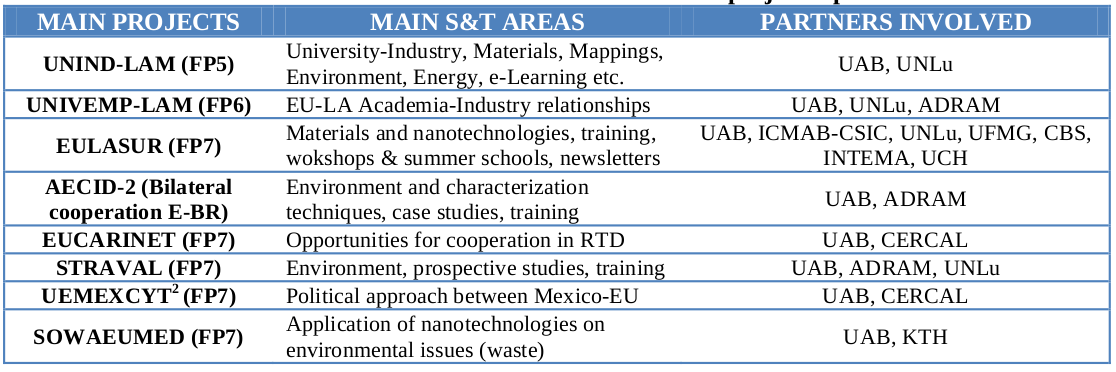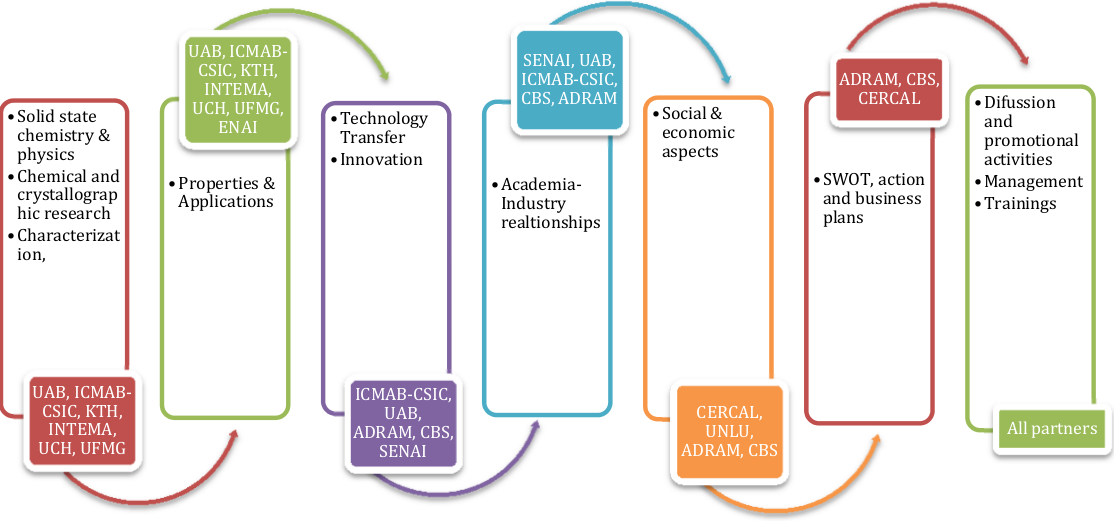SCIENTIFIC QUALITY OF THE PARTNERS
The roles given to the EULA-NETCERMAT partners correspond to their S&T expertise and transnational/EU project experience, given in the synthetic table below (see Table). On this basis, the activities have been distributed accordingly to ensure their completion. The consortium is established in an interdisciplinary and complementary way (Academia – Enterprise) in order to combine the best existing expertise in the required fields in both, EU and LA countries. The commitment of the participants is proved by the fact that all of the participants have experience within EU funded research projects (Table 6 & Annex with decription of relevant activities of the consortium). EULA-NETCERMAT includes members of other consortiums, like EULASUR, EUCARINET, UEMEXCYT2 and STRAVAL etc. or from bilateral funded projects: AECID-D (Spain – Brazil).

COMPLEMENTARITIES/SYNERGIES BETWEEN THE PARTNERS
The value chain of EULA-NETCERMAT, involves a series of phases and activities, given in the following figure, in which the members of this consortium present a high expertise degree (in terms of Transnational/EU project experience) and a long-lasting cooperation as it is demonstrated by the high number of joint activities which demonstrate the complementarities and sinergies between partners. EULA-NETCERMAT, will also includes partners with a longlasting experience and cooperation with industrial partners (SENAI, ADRAM, CBS, UNLu etc.) delivering expertise, establishing and developing schemas of technology transfer (UAB, ICMAB-CSIC etc.) as well as establishing future common research projects (FP8, CDTI etc.). This practical application of research aims at reducing the gap between science and industry (CREST Study: Brazil case, Prof. Jose Luis Briansó EC publication September 2008).

Whilst most partners will contribute to all of the work packages and many of the key tasks, their specific roles are structured in several levels through the coordination, task leaders and work packages leaders, reflecting the complementarities of the partners. This will ensure distribution of activities and full commitment of all the participants due to certain synergies and complementarities, such as:
- Interdisciplinary and complementary consortium with sustainable and solid partnerships combining the best of existing expertise in the required fields in both, EU and LA countries toto form a solid basis for future joint research proposals in applications of MACs and R&D (experience within EU funded projects).
- Actual existing bilateral working experiences through several projects such as those from FP5 to FP7 or AECID-PCI International Cooperation Spanish Agency for Inter-universitary cooperation programme with LA countries, from 2000 up to now. All the members of the consortium participate in others networks or projects; this is an important point for future calls (FP8) or bilateral activities under national programs with international dimension.
- UAB and UNLu are involved in a Master (coordinated by UNLu) in RTD Management, Technology Transfer and Innovation (324 hours in total), supported by the Argentinean Government (2011-2013). This Master include eleven AR-universities and Governmental Agencies (G-TEC programme)
- Many areas of knowledge are included in the proposal in a coherent way and high level professionals: Physics, Chemistry, Crystallography, Pollution control, Business, Academia-Enterprise relationships, Entrepreneurs, Social and Econonic studies, @Learning and Platform expertise, Civil Engenering, Materials and testing materials etc.
- A multi geo-linguistic character in response to geographic political and scientific needs as an added value for the good co-ordination and implementation of the activities in each sub-region with the aim to coordinate in a coherent regional way.
- A multidisciplinary character with partners coming from academia and the private sector (CBS, ADRAM, SENAI), covering different scientific fields, having competences and skills complementary to each other partners within the objectives of the proposed action. The involved partners are representatives of prestigious universities, which will make possible to gather the most relevant scientific information for knowledge transfer, useful point to strength the cooperation Academia – Industry.
- A multi-stakeholder nature making the richness of intellectual and strategic human resource for a project such as EULA-NETCERMAT and with capabilities to mobilise research groups not only from the consortium but also from outside and able to access national and international R&D policy makers.

